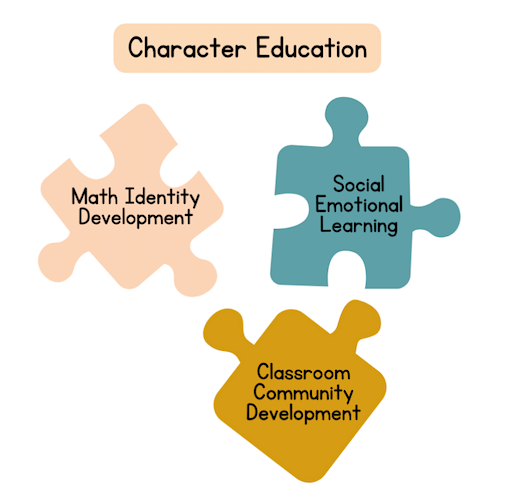Math: the Perfect Place to Teach Character
By Mona Iehl

I recently sat down at a TINY table with 3 kindergarten students to work on subtraction. I excitedly told them we’d be solving some problems today and using math tools. The three girls around the table immediately started to groan…
“I am NOT good at math.”
“You like math? It’s SO hard.”
“Why do we have to do this?”
To be honest with you, I was surprised. I expected this type of response from older students, but these kids were five and full of energy and excitement for nearly everything at school. However, the pervasive negative math identity monster had already reached their innocence and brought along all its slimy and smelly messages.
These three five-year-olds were expressing themselves freely, something older students are hesitant to do, so for that I was thankful. I didn’t launch into a lecture on the values of mathematics and a growth mindset. Instead, I took note of attitudes about math and launched into 15 minutes of fun problem solving in hopes of shifting their mindset through a positive experience.
Character + Math = Math Vision
Character education can be traced back to the 1700s when Benjamin Franklin said, “… nothing is of more importance for the public weal, than to form and train up youth in wisdom and virtue.” Flash forward 300-ish years to 2005 when the US Department of Education published this definition, “Character education teaches the habits of thought and deed that help people live and work together as families, friends, neighbors, communities and nations.” Source
The way I think about character education is seeing our students as whole humans, not just vessels for learning the curriculum. I see my job as a teacher to help my students be their best selves…to be the people that will go on to change the world, make a positive impact on the lives of others, and solve problems in ways that build us up as a community.
Character education and academics work together harmoniously when our work is driven by core values such as respect, justice, citizenship, and responsibility for self and others.

The mission of our work is to inspire and empower our students to be better people because of the work they do within our classroom that will make an impact on the world outside of our four walls. The answers we seek to the problems we face each day in our classes lie within each student’s potential.
Math is the perfect place to foster the development of character because our students are facing obstacles like low self-confidence, past failures, and a negative self-image as a mathematician. Character education is an overarching approach to developing a learning environment that fosters the development of each individual as a learner and human being.
Within character education you’ll find strong social and emotional learning embedded throughout the day as well as the development of a classroom community that fosters math identity development.
Each of these approaches takes a student-centered stance toward teaching and learning. By positioning the students’ actions and thinking at the center, teachers are able to be responsive while also developing strong practices of reflection that empower students to take ownership over their learning.
This requires the adults to take a step back from the traditional role of leading the learning and to instead assume a role as the guide. Typically, teachers hold the knowledge, ask the questions, validate if the answers are correct, and demonstrate the best methods to solve problems. However, if our endeavor is to teach students to persevere, then we must consider our role carefully.
We need to reconsider our role so that we see the assets each child possesses and then coach them to express their ideas in order to build confidence that leads to mastery of mathematical standards. Our voices do not need to be the loudest. Instead we can ECHO back to our students their ideas and help each student embrace their leadership role in their learning journey.
The ECHO Role of the Math Teacher
We can help our students build their confidence and a positive math identity by carefully considering how we facilitate our classroom. I suggest we use ECHO to guide our teacher moves.
- E: Empathize (Offer understanding and compassion)
- C: Cultivate (Guide students to develop self-competence)
- H: Honor (Value and respect student voice)
- O: Open (Open ourselves and embrace students’ ideas and capacity)
E: Empathy – Understanding and Compassion
Empathy is empowering. By definition, empathy is to sense what others are feeling. Empathy expresses our confidence in the other person’s strength to overcome their challenges while acknowledging the challenge they face.
Often when math students struggle, we express sympathy and attempt to rescue them. That might sound like, “I’m so sorry this problem is difficult. I know math is hard for you. I am not trying to cause you more confusion or pain, I’ve chosen the wrong problem.” This response makes the students’ struggle about the teacher and shifts the teachers’ role from support to savior.
Teachers often feel this tug to help students during a time of struggle. However, sometimes our help – if framed with sympathy rather than empathy – can communicate that the student is a victim in need of saving, in turn deteriorating their self-confidence and backfiring on the teacher’s efforts to help the student.
The alternative? The teacher might express empathy to a frustrated problem solver by agreeing that this problem is really hard, but they are confident the student can make it through. Phrases the teacher might say to express empathy include:
• You’re right this is challenging. I know you have what you need inside of you to solve this problem.
• I’m here for you.
• I know you’re a strong thinker, and this is your problem to solve.
• You might need some guidance, but you have what it takes to solve this problem.
This approach expresses confidence while still acknowledging the students’ struggle and the feelings unearthed from the struggle. The stance of empathy from a teacher to a student increases bonding and relationships that are vital to learning. This type of response builds students’ resilience and self- confidence because the teacher is not rescuing.
C: Cultivate – Cultivating self-competence
Cultivating students’ self-competence helps students see they have the skills needed to be successful. Self-competence refers to academic, personal, social, and practical skills that might be needed to accomplish a task or conquer a challenge. When a student possesses self-competence, they are able to self-manage, set goals, reflect on those goals, and accept responsibility for taking action. This intentional shift in our role to one of “cultivator” helps students truly build the skills they need to problem solve.
H: Honor – Valuing and respecting student voice
Students’ voices in our math class must be trusted and respected. Understanding each student’s perspective can help us attend to their strengths as mathematicians. When we actively listen to students, we better understand their mathematical thinking. Additionally, listening to students gives us insights into their struggle and an opportunity to acknowledge their feelings with empathy.
Honoring students’ voices shows students “your voice matters.” Although this is a trendy phrase, it is difficult to show students their voice matters in modern day classrooms where the power dynamic is set up for teachers to be the holders of power and students to be the followers. That’s why we are shifting our role from leader to guide through intentional actions that honor and respect the value inherent in student voice.
O: Open – Open ourselves and embrace students’ ideas and capacity
Our trust in students’ ideas and capacity to learn is the overarching theme and most important aspect of our role as the guide in the math classroom. We cannot inspire ownership or cultivate motivation in our students if we do not trust students.
As teachers, leaders, and guides we must ensure our students know that we believe they have the capacity to solve problems and do mathematics. This means leaving behind practices that do not serve this purpose and moving on to empowering students through our trust in them.
I suggest you take time to carefully reflect on the way you express trust in students. Consider…
- Your classroom structures
- Your relationships with students
- How you approach mistakes
- Your grading practices
- The time you plan for students to explore
- Your math discussions and who is talking
- The reflection practices you engage students with
Each of these elements is vital to a classroom that embraces students’ ideas and has the capacity to build math proficiency and math identity.
How We Define Our Role Is Key
Mathematics is the place where students can be empowered to build both their character and their math proficiency – but only when we position ourselves in the role of guide. Our role in the math classroom can be the difference. As we end this year and look ahead to the future, consider the role you’ll take. What will you prioritize?
I hope ECHO has inspired you to embrace empathy, cultivate self-competence, honor student voice, and trust in your students’ capacity to learn mathematics. Connecting math learning and character education can impact how you show up as your students’ guide to build math proficiency and positive math identities.
Mona Iehl (@HelloMonaMath) has been a fifth- and sixth-grade math teacher in Chicago, Illinois for six years. She started her 14-year year teaching career at the primary level but found her home in the middle grades. This year she has taken on the role of coach. For more details about the teaching methods she highlights here, visit her website and browse her other MiddleWeb posts.
Mona recently took her passion for helping teachers and students find their inner mathematician to a podcast. Listen in at @HonestMathChat. More fluency resources for multiplication and division systems are available at her Mona Math TPT shop.






























